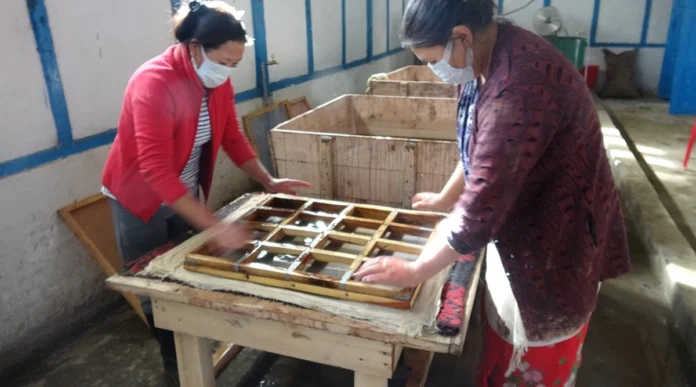The ancient craft of Monpa handmade paper is making a comeback. With roots tracing back over 1,000 years, this heritage craft, once in danger of fading into obscurity, has found a new lease on life in the Monpa community of Arunachal. Thanks to the commitment of local artisans and support from various cultural preservation initiatives, Monpa handmade paper is now poised to regain its place in the cultural and economic fabric of the region.
The Rich History of Monpa Handmade Paper
Monpa handmade paper, traditionally produced by the indigenous Monpa people of the Tawang and West Kameng districts in Arunachal Pradesh, has a rich history dating back to ancient times. The process of crafting this paper involves the meticulous preparation of plant fibers, primarily from the lokta plant, which is found in the high-altitude areas of the region. The fibers are soaked, pulped, and then spread onto wooden frames to dry in the sun, creating sheets of paper that are both durable and uniquely textured.
This paper, often known for its natural off-white color and smooth finish, has historically been used for various purposes, including writing, painting, and making religious manuscripts. In the Buddhist-dominated Monpa culture, the paper was especially significant in the production of sacred texts and scriptures, which were used in religious ceremonies and rituals. The durability and aesthetic appeal of the paper made it a prized material not only in the region but also in neighboring Tibet and Bhutan, where it was often exported.
However, as modern technology and mass-produced paper flooded the market, the demand for Monpa handmade paper began to decline. The traditional craft faced the threat of extinction, as fewer artisans continued to practice the techniques passed down through generations.
A Revival Through Collective Efforts
The revival of Monpa handmade paper has been made possible through the collective efforts of local artisans, cultural organizations, and the government of Arunachal Pradesh. Recognizing the cultural and historical significance of this ancient craft, several initiatives have been launched to revive and promote the art of handmade paper production.
One of the key drivers behind the revival is the active involvement of the Monpa community, which has worked diligently to reintroduce traditional methods and tools to the younger generation. Artisans have been trained in the traditional papermaking process, ensuring that the techniques are passed on to future generations. In addition to this, a number of workshops and exhibitions have been organized to showcase the craft, attracting both local and national interest.
The government of Arunachal Pradesh, under its various cultural preservation programs, has also extended support to the initiative. Financial assistance has been provided to artisans for raw materials, equipment, and training programs. Furthermore, efforts have been made to establish local cooperatives and support the marketing of Monpa handmade paper, ensuring that the products find a market both within and outside the state.
Modern-Day Applications and Economic Opportunities
The resurgence of Monpa handmade paper is not just a victory for cultural preservation but also presents new economic opportunities for the local population. With the growing interest in sustainable and eco-friendly products, Monpa handmade paper has found a new market, particularly among eco-conscious consumers and businesses looking for unique, handcrafted materials.
Today, the paper is used for a variety of modern applications, including stationery, notebooks, greeting cards, and decorative items. Additionally, its cultural value has led to increased demand in the art and craft sector, where artists and collectors appreciate the paper’s authenticity and texture. The revival of this craft has thus created new avenues for local artisans, boosting the regional economy while also preserving an ancient tradition.
The resurgence of Monpa paper has also attracted the attention of tourists and cultural enthusiasts. Tawang, known for its Buddhist monasteries and breathtaking landscapes, has become a hub for visitors interested in exploring the region’s rich cultural heritage, including the Monpa handmade paper craft. As a result, the craft has become an important part of the region’s tourism sector, with local artisans selling their handmade products to tourists as souvenirs.
Challenges and the Road Ahead
While the revival of Monpa handmade paper is an encouraging development, challenges remain. The production of high-quality paper requires access to specific raw materials, including the lokta plant, which is not easily available in large quantities. Additionally, the market for handmade paper is still niche, and there is a need for continued promotion and education about its cultural significance and benefits.
To address these challenges, continued support from the government, non-governmental organizations, and local businesses will be crucial. Investing in sustainable raw material sourcing, promoting the craft through digital platforms, and encouraging greater participation from the younger generation are key steps toward ensuring the long-term survival of this ancient art form.
The revival of Monpa handmade paper is a testament to the resilience of Arunachal Pradesh’s indigenous cultures and the power of community-driven initiatives. This 1,000-year-old heritage craft is not only a symbol of the region’s rich cultural heritage but also a source of livelihood and economic empowerment for local artisans. As the craft continues to thrive, it serves as a reminder of the importance of preserving traditional knowledge while adapting it to the demands of the modern world. The comeback of Monpa handmade paper is a significant step toward preserving the cultural identity of Arunachal Pradesh for future generations.

